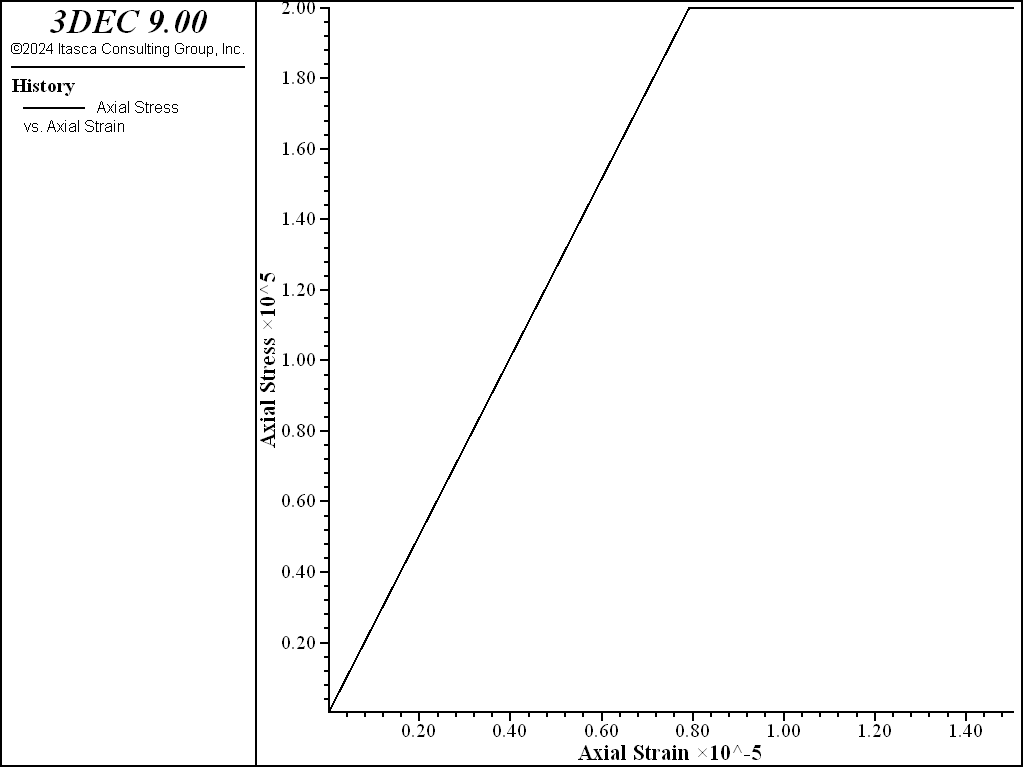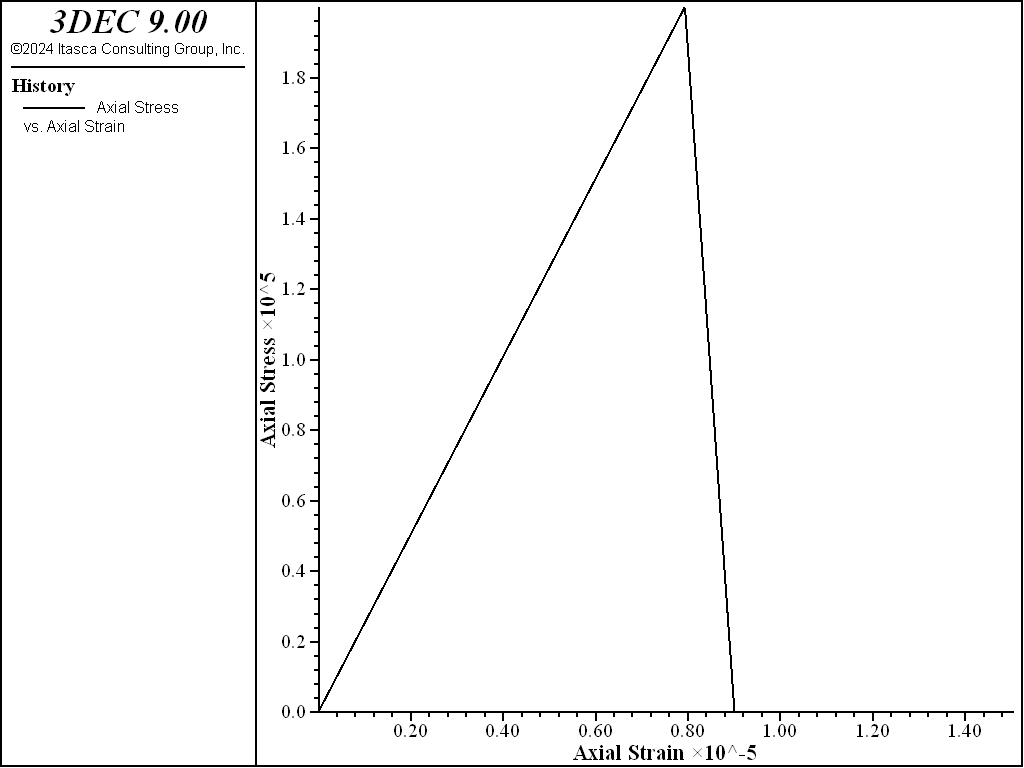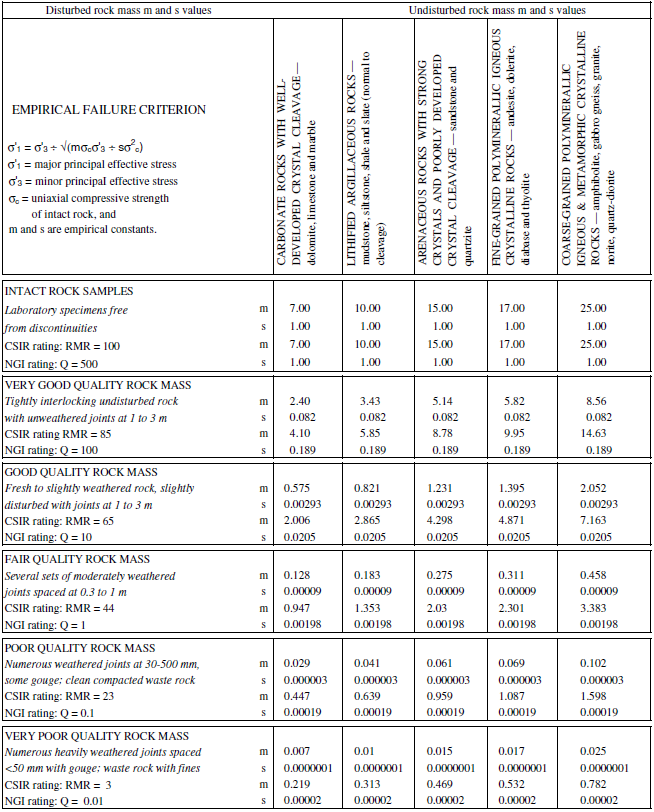Zone Properties
Properties assigned to zones in blocks are generally derived from laboratory testing programs. The following four sections describe intrinsic (laboratory-scale) properties and list common values for various rocks.
Mass Density
The mass density is required for every non-void material in a 3DEC model. This property has units of mass divided by volume, and does not include the gravitational acceleration. In many cases, the unit weight of a material is prescribed. If the unit weight is given with units of force divided by volume, then this value must be divided by the gravitational acceleration before entering it as 3DEC input for density.
Intrinsic Deformability Properties
Most material models for deformable blocks in 3DEC assume an isotropic material behavior in the elastic range described by two elastic constants (bulk modulus, \(K\), and shear modulus, \(G\)). The elastic constants, \(K\) and \(G\), are mostly used in the 3DEC examples instead of Young’s modulus, \(E\), and Poisson’s ratio, \(ν\), because it is believed that bulk and shear moduli correspond to more fundamental aspects of material behavior than do Young’s modulus and Poisson’s ratio. (Instabilities can result when using \(E\) and \(ν\) when \(ν\) approaches 0.5). It is possible however to use \(E\), and \(ν\) in 3DEC and some examples do use these parameters instead.
The equations to convert from (\(E,ν\)) to (\(K,G\)) are:
The equation above should not be used blindly when \(ν\) is near 0.5, since the computed value of \(K\) will be unrealistically high and convergence to the solution will be very slow. It is better to fix the value of \(K\) at its known physical value (estimated from an isotropic compaction test or from the p-wave speed), and then compute \(G\) from \(K\) and \(ν\).
Some typical values for elastic constants are summarized in the following table for selected rocks:
\(E\) (GPa) |
\(ν\) |
\(K\) (GPa) |
\(G\) (GPa) |
|
|---|---|---|---|---|
Berea sandstone |
19.3 |
0.38 |
26.8 |
7.0 |
Hackensack siltstone |
26.3 |
0.22 |
15.6 |
10.8 |
Bedford limestone |
28.5 |
0.29 |
22.6 |
11.1 |
Micaceous shale |
11.1 |
0.29 |
8.8 |
4.3 |
Cherokee marble |
55.8 |
0.25 |
37.2 |
22.3 |
Nevada Test Site granite |
73.8 |
0.22 |
43.9 |
30.2 |
Intrinsic Strength Properties
The basic criterion for block material failure in 3DEC is the Mohr-Coulomb relation, which is a linear failure surface corresponding to shear failure:
where: |
\(N_\phi\) |
= \((1+\sin{\phi}) / (1 - \sin{\phi})\); |
\(\sigma_1\) |
= major principal stress (compressive stress is negative); |
|
\(\sigma_3\) |
= minor principal stress; |
|
\(\phi\) |
= friction angle; and |
|
\(c\) |
= cohesion. |
Shear yield is detected if \(f_s < 0\). The two strength constants, \(\phi\) and \(c\), are conventionally derived from laboratory triaxial tests.
The Mohr-Coulomb criterion loses its physical validity when the normal stress becomes tensile. But, for simplicity, the surface is extended into the tensile region to the point at which \(\sigma_3\) equals the uniaxial tensile strength, \(\sigma^t\) . The minor principal stress can never exceed the tensile strength – i.e.,
Tensile yield is detected if \(f_t > 0\). Tensile strength for rock and concrete is usually derived from a Brazilian (or indirect tensile) test. Note that the tensile strength cannot exceed the value of \(\sigma_3\) corresponding to the apex limit for the Mohr-Coulomb relation. This maximum value is given by
Typical values of cohesion, friction angle and tensile strength for a representative set of rock specimens are listed below.
friction |
cohesion |
tensile |
|
|---|---|---|---|
Berea sandstone |
27.8 |
27.2 |
1.17 |
Repetto siltstone |
32.1 |
34.7 |
— |
Muddy shale |
14.4 |
38.4 |
— |
Sioux quartzite |
48.0 |
70.6 |
— |
Indiana limestone |
42.0 |
6.72 |
1.58 |
Stone Mountain granite |
51.0 |
55.1 |
— |
Nevada Test Site basalt |
31.0 |
66.2 |
13.1 |
The ubiquitous-joint component of the bilinear model also requires strength properties for the planes of weakness. Joint properties are discussed in Joint Properties. The properties for joint cohesion and friction angle also apply for the ubiquitous-joint model.
Post-Failure Properties
In many instances, particularly in mining engineering, the response of a material after the onset of failure is an important factor in the engineering design. Consequently, the post-failure behavior must be simulated in the material model. In 3DEC, this is accomplished with properties that define four types of post-failure response:
shear dilatancy;
shear hardening/softening;
volumetric hardening/softening; and
tensile softening.
These properties are only activated after the onset of failure, as defined by the Mohr-Coulomb relation. Shear dilatancy is assigned for the Mohr-Coulomb and bilinear strain-hardening/softening ubiquitous joint model. Hardening/softening parameters are assigned for the bilinear model.
Shear Dilatancy
Shear dilatancy, or dilatancy, is the change in volume that occurs with shear distortion of a material. Dilatancy is characterized by a dilation angle, ψ, which is related to the ratio of plastic volume change to plastic shear strain. This angle can be specified in the block plasticity models in 3DEC. The dilation angle is typically determined from triaxial tests or shear box tests. For example, the idealized relation for dilatancy, based on the Mohr-Coulomb failure surface, is depicted for a triaxial test in Figure 1. The dilation angle is found from the plot of volumetric strain versus axial strain. Note that the initial slope for this plot corresponds to the elastic regime, while the slope used to measure the dilation angle corresponds to the plastic regime.
Figure 1: Idealized relation for dilation angle, \(\psi\), from triaxial test results (Vermeer and de Borst 1984)
For soils, rocks and concrete, the dilation angle is generally significantly smaller than the friction angle of the material. Vermeer and de Borst (1984) report the following typical values for \(\psi\):
dense sand |
15º |
loose sand |
< 10º |
normally consolidated clay |
0º |
granulated and intact marble |
12º − 20º |
concrete |
12º |
Vermeer and de Borst observe that values for the dilation angle are approximately between 0º and 20º, whether the material is soil, rock or concrete. The default value for the dilation angle is zero for all of the constitutive models in 3DEC.
The dilation angle can also be prescribed for the joints in the ubiquitous-joint component of the bilinear model. This property is typically determined from direct shear tests, and common values can be found in the references discussed in Joint Properties.
Shear Hardening/Softening
The initiation of material hardening or softening is a gradual process once plastic yield begins. At failure, deformation becomes more and more inelastic as a result of micro-cracking in concrete and rock, and particle sliding in soil. This also leads to degradation of strength in these materials and the initiation of shear bands. These phenomena, related to localization, are discussed further in Localization, Physical Instability, and Path-Dependence.
In 3DEC, shear hardening and softening are simulated by making Mohr-Coulomb properties functions of plastic strain (see see Strain-Softening/Hardening Mohr-Coulomb (SSoft) Model). These functions can be specified by using the table command.
Hardening and softening parameters must be calibrated for each specific analysis with values that are generally back-calculated from results of laboratory triaxial tests. This is usually an iterative process. Investigators have developed expressions for hardening and softening. For example, Vermeer and de Borst (1984) propose the frictional hardening relation
where: |
\(\phi\) |
= ultimate friction angle; |
\(\phi_m\) |
= mobilized friction angle; |
|
\(e_p\) |
= plastic strain; and |
|
\(e_f\) |
= hardening constant. |
Numerical testing conditions can influence the model response for shear hardening/softening behavior. The rate of loading can introduce inertial effects; this can be controlled by monitoring the unbalanced force and reducing the loading rate accordingly. A FISH function can be used to control the loading rate automatically. The results are also mesh-dependent. Thus, it is important to evaluate the model behavior for differing zone sizes and mesh orientations whenever performing an analysis involving shear hardening or softening.
Tensile Softening
At the initiation of tensile failure, the tensile strength of a material will generally drop to zero. The Mohr-Coulomb model does not strain-soften in tensile failure. The tensile stress remains constant after the tensile stress limit has been reached. Use the Strain Softening model to simulate the dop of tensile stress to zero. The rate at which the tensile strength drops, or tensile softening occurs, can also be controlled by the plastic tensile strain in 3DEC. This function is accessed as a model property, and the rate of change of tensile strength can be specified by using the table command.
A simple tension test (the example listed below) illustrates perfectly plastic tensile failure, as built into the Mohr-Coulomb model, and brittle tensile failure in the strain-softening model. The model is a tension test on a cubic block composed of Mohr-Coulomb material. The ends of the sample are pulled apart at a constant velocity. The test is performed with both the Mohr-Coulomb and the Strain-Softening zone models.
model new
model large-strain off
block create brick 0 1 0 1 0 1
block zone generate hexahedra divisions 1 1 1
; Mohr-Coulomb model
block zone cmodel assign mohr-coulomb
block zone property density=2500 bulk=1.19e10 shear=1.1e10
block zone property cohesion 2.72e5 friction 44 tension 2e5
; strain softening
;block zone cmodel assign strain-softening
;block zone property density 2500 bulk=1.19e10 shear=1.1e10
;block zone property cohesion 2.72e5 friction 44 tension 2e5
;block zone property table-tension 1
;table '1' add 0 2e5 9e-6 0
;
[velocity = 1e-5]
[area = 1.0]
[length = 1.0]
[ztop = 0.9]
fish define ax_str
; stress is the sum of reaction forces divided by area
local str = 0.0
loop foreach ig block.gp.list
if block.gp.pos.z(ig) > ztop then
str = str + block.gp.force.reaction.z(ig)
endif
end_loop
ax_str = str / area
; calculate strain from velocity of the platens
ez_str = 2.0*velocity*mech.time / length
end
fish history name 'Axial Stress' ax_str
fish history name 'Axial Strain' ez_str
block gridpoint apply velocity-z [-1.0*velocity] range position-z 0.0
block gridpoint apply velocity-z [velocity] range position-z 1.0
model cycle 15000
model save 'mc'
The plot of \(\sigma{zz}\)-stress versus \(zz\)-strain (Figure 2) shows that the average stress remains constant for the Mohr-Coulomb model. If the example above is repeated with the Strain-Softening model and a tensile softening table, a softening response can be produced, as shown in Figure 3.

Figure 2: \(\sigma_{zz}\)-stress versus \(zz\)-strain for tension test with the Mohr-Coulomb model

Figure 3: \(\sigma_{zz}\)-stress versus \(zz\)-strain for tension test with the Strain-Softening model and a tensile-softening table
The brittleness of the tensile softening can be controlled by the plastic tensile strain function, by using the Strain-Softening instead of the Mohr-Coulomb model. As with the shear-softening, the tensile-softening must be calibrated for each specific problem and mesh size, since the results will be mesh-dependent.
Extrapolation to Field-Scale Properties
The material properties used in the 3DEC model should correspond as closely as possible to the actual values of the physical problem. Laboratory-measured properties generally should not be used directly in a 3DEC model for a full-scale problem. The presence of discontinuities in the model will account for a good portion of the scaling effect on properties. However, some adjustment of block properties will still probably be required to represent the influence of heterogeneities and micro-fractures, fissures and other small discontinuities on the rock mass response.
Several empirical approaches have been proposed to derive field-scale properties. Some of the more commonly accepted methods are discussed.
Deformability of a rock mass is generally defined by a modulus of deformation, \(E_m\). If the rock mass contains a set of relatively parallel, continuous joints with uniform spacing, the value for Em can be estimated by treating the rock mass as an equivalent transversely isotropic continuum. The relations in Joint Properties can then be used to estimate \(E_m\) in the direction normal to the joint set. Deformation moduli can also be estimated for cases involving more than one set of discontinuities. The references listed in Joint Properties provide solutions for multiple joint sets.
In practice, the rock mass structure is often much too irregular, or sufficient data are not available, to use the preceding approach. It is common to determine \(E_m\) from a force-displacement curve obtained from an in-situ compression test. Such tests include plate bearing tests, flatjack tests and dilatometer tests.
Bieniawski (1978) developed an empirical relation for \(E_m\) based on field test results at sites throughout the world. The relation is based on rock mass rating (RMR). For rocks with a rating higher than 55, the test data can be approximately fit to
The units of \(E_m\) are GPa.
For values of \(E_m\) between 1 and 10 GPa, Serafim and Pereira (1983) found a better fit, given by
References by Goodman (1980) and Brady and Brown (1985) provide additional discussion on these methods.
The most commonly accepted approach to estimate rock mass strength is that proposed by Hoek and Brown (1980). The generalized Hoek-Brown failure criterion for jointed rock masses is defined by (Hoek and Brown 1997):
where \(\sigma'_{1}\) and \(\sigma'_{3}\) are the maximum and minimum effective stress at failure, respectively (compressive stresses are positive), \(m_b\) is the value of the Hoek-Brown constant \(m\) for the rock mass, \(s\) and \(a\) are constants that depend upon the characteristics of the rock mass, and \(\sigma_{ci}\) is the uniaxial compressive strength of the intact rock pieces.
The tensile strength of the rock mass is estimated by Hoek and Brown (1997) to be
Three properties are required in order to use the Hoek-Brown criteria (Equations (8) and (9) above):
the uniaxial compressive strength, \(\sigma_{ci}\), of the intact rock pieces;
the Hoek-Brown constant, \(m_i\), for the intact rock pieces; and
the value of the Geological Strength Index, GSI, for the rock mass. This provides an estimate for the Hoek-Brown constants, \(s\), \(m_b\), and \(a\).
For the intact rock pieces that compose the rock mass, Equation (8) becomes
The values for \(\sigma_{ci}\) and the constant \(m_i\) should be determined by statistical analysis of the results of a set of triaxial tests. The recommended procedure is given by Hoek and Brown (1997). This paper also presents estimates of \(\sigma_{ci}\) and \(m\) for preliminary design calculations when laboratory test results may not be available.
The Geological Strength Index (GSI) provides a system for estimating the reduction in rock mass strength. Two tables from Hoek and Brown (1997) can be used to estimate GSI (see the two tables below). Hoek and Brown (1997) then give the following relation between GSI and \(m_b\), \(s\) and \(a\):
For GSI > 25,
and
For GSI < 25,
and
Table #zprops-tab-lbSE (from Hoek and Brown 1988) presents typical values for \(m\) and \(s\) for undisturbed and disturbed rock masses.
It is possible to estimate Mohr-Coulomb friction angle and cohesion from the Hoek-Brown criterion (see, for example, Hoek 1990).
For a given value of \(\sigma_3\), a tangent to the function (Equation (8)) will represent an equivalent Mohr-Coulomb yield criterion in the form
where \(N_{\phi} = \tfrac{1+\sin{\phi}}{1-\sin{\phi}} = \tan^2(\tfrac{\phi}{2}+45º)\).
By substitution, \(\sigma^M_c\)
\(\sigma^M_c\) is the apparent uniaxial compressive strength of the rock mass for that value of \(\sigma_3\).
The tangent to the Equation (8) is defined by
The cohesion (\(c\)) and friction angle (\(\phi\)) can then be obtained from \(N_{\phi}\) and \(\sigma^M_c\):
(Click table to enlarge.)
Spatial Variation and Randomness of Property Distribution
Material properties can be specified to adjust or to vary as a function of grid position. In fact, a different property can be assigned to every zone in a 3DEC model, regardless of model size.
There are two commands avialable in 3DEC to specfiy material properties. The first, block zone property, allows multiple properties to be specified in a single command. This is convenient to completely specify properties in different regions, where that property does not vary within that region.
The second can only specify one property at a time, but has optional keywords that allow the property value to be automatically varied in space. This is the block zone property-distribution command. Among the available keywords are add,
multiply, gradient, and vary, which can be used to provide fixed or linear variations of properties with position. For example, the following command provides a linear variation of cohesion in the \(x\)-direction:
block zone property-distribution cohesion 1e6 gradient (-1e5,0,0)
An initial profile of a property can also be assigned via FISH.
With 3DEC, it is also possible to study the influence of nonhomogeneity in a material. Any type of statistical property distribution can be introduced, as each element may have a unique property value. Two optional keywords are available to apply a random distribution of a selected property with the zone property-distribution command. The keyword
deviation-gaussian assumes a normal (Gaussian) distribution for the property, with a mean value, \(v\), and standard deviation, \(s\). The keyword deviation-uniform
assumes a uniform distribution with mean value, \(v\), and standard deviation, \(s\). Be careful to ensure that properties do not acquire negative values if \(s\) is large. As an example, the following command would give a mean friction angle of 40° with a standard deviation of ±5%:
block zone property-distribution friction 45 deviation-gaussian 2
| Was this helpful? ... | Itasca Software © 2024, Itasca | Updated: Nov 12, 2025 |

